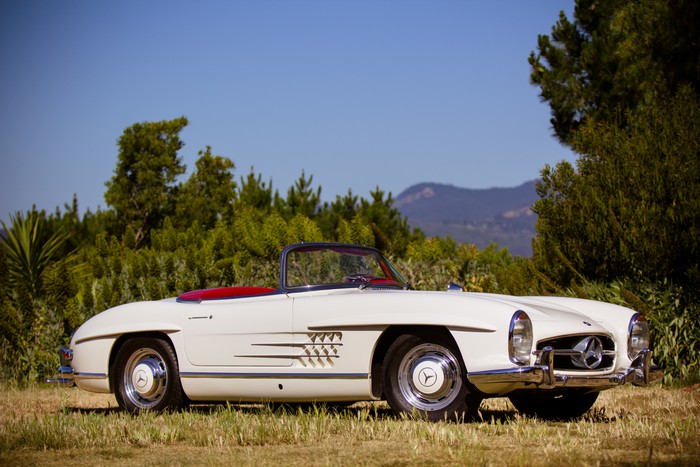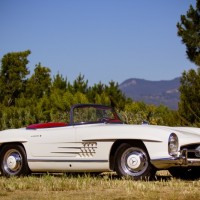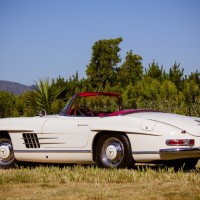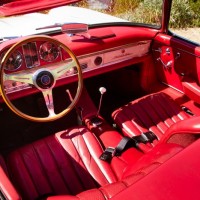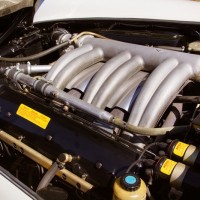- A rare and sought-after disc-brake, alloy-block roadster
- A two-owner car from new
- Less than 15,000 total miles
- An extremely authentic example
- Beautifully presented original interior
- Equipped with Karl Baisch factory-fitted luggage and optional hard top
- The ultimate specification 300SL roadster
SCM Analysis
Detailing
| Vehicle: | 1963 Mercedes-Benz 300SL Roadster |
| Number Produced: | 1,858 |
| Original List Price: | $13,000 |
| Tune Up Cost: | $5,000 |
| Chassis Number Location: | Tag on firewall and stamped into front cross member |
| Engine Number Location: | Riveted tag and stamped number on front right side of block below head |
| Club Info: | 300SL Gullwing Group |
| Website: | http://www.gullwinggroup.com |
This car, Lot 66, sold for $1,595,000, including buyer’s premium, at Gooding & Company’s Pebble Beach Auction on Aug. 18, 2012.
I seem to be Sports Car Market’s go-to guy when it comes time to do a profile on Mercedes-Benz 300SLs, and it’s enlightening to go back through my archives and watch the prices. It was a front-cover headline in the December 2006 issue (German Profile, p. 56) when a 1957 300SL Roadster we restored smashed expectations and sold for $605,000 — a strong $200k above the perceived current market. Fast forward to September 2011, and another of my profiles had a 1957 300SL Roadster selling for $752,130 at Artcurial’s Sur Les Champs auction in Paris (German Profile, p. 66).
Since that time, the market for Mercedes-Benz 300SL cars — Gullwings and Roadsters — has been steadily rising, along with most blue-chip European sports cars of the 1950s and 1960s. We are now at the point at which there are more people — with money —who want these cars than there are cars, and this situation is forcing the prices up accordingly.
A cash market
Unlike the late 1980s when investors sparked the market — and bought cars with bank loans — today’s blue-chip collector car enthusiasts seem to have their own cash in hand and like to have some cars as part of their portfolio. I have never been a proponent of buying cars for investment. Buy them because you’ve worked hard, have the disposable income, and love them.
Having said that, if you look back on the last 30 years, they have been good investments. Sure they may have stalled, or gone down for a while, but they have always bounced back much stronger.
Why so many low-mileage roadsters?
Mercedes-Benz built only 209 disc-brake, alloy-engine Roadsters in late 1962–63. The cars were getting a little long in the tooth, and they were hard to sell. Maybe this was because the body design hadn’t changed in seven years, while new cars, such as the Jaguar E-type, Ferrari 250 and Aston Martin DB5 were catching the eyes of enthusiasts.
From evidence we have been gathering from cars that have been through our shop, it appears that Mercedes-Benz assembled the last few hundred 300SL cars in primer — and then painted them to customer specifications after they were sold. We’ve had four under-20k-miles, original-paint, disc/alloy cars that have overspray on the chassis, detectable tape lines and primer under the chrome.
In 1963, the list price of a 300SL Roadster was nudging $13,000 — when most of their competitors were less than half of that. These cars were a hard sell indeed for most dealers. As such, very wealthy people bought a lot of the cars for their second or third car — not primary transportation. I believe this is why we see so many low-mileage cars compared to other makes from the same period.
Disc-brake, alloy-engine cars on top
The pecking order for 300SL Roadsters is as follows: low-mileage, original paint, disc brake/alloy engine cars. Next in line are disc brake/steel engine cars or knockoff wheels. Then come expertly restored cars — from top shops —and so on down the line.
I tracked disc brake/alloy engine cars for the entire summer of 2012, as I had a client who desperately had to have one. In June, the market was around $900k for a good, no-stories car. I approached three of my customers who had cars and offered them $1m.
To a man they said, “Thank you, that’s a great offer but I don’t need the money, I love the car and where would I put the money that would be better than keeping the car?” And, of course, they were right. I’m finding the only reason most collectors consider selling a cars is to buy another.
Low miles with everything brings the money
I inspected this Roadster for a client before the auction. It was indeed a true, low-mileage example with an incredible original interior. The color change from DB608 Light Ivory to DB50 White was well done, and the car had a great look to it. The fact that it had chromed wheels, a hard top, European lights and original luggage was icing on the cake.
These days, original luggage in good condition adds more than $30k, and hard tops add another $25k to $40k. I knew this car would be strong on the block, but I certainly did not expect almost $1.6m.
This sale just goes to show you how strong auctions can be for certain cars. You just need two people who want the same thing — and won’t back down. In my mind, this sale does not make every disc brake/alloy engine roadster worth this kind of money, but it does give you an indication of where the market is going. As the adage goes, “You cannot pay too much, but you may buy too soon.”
I’d call this car very well sold, but I have a feeling that when we look back at prices for the next 300SL profile, we will see that it was well bought as well. ?
(Introductory description courtesy of Gooding & Company.)
